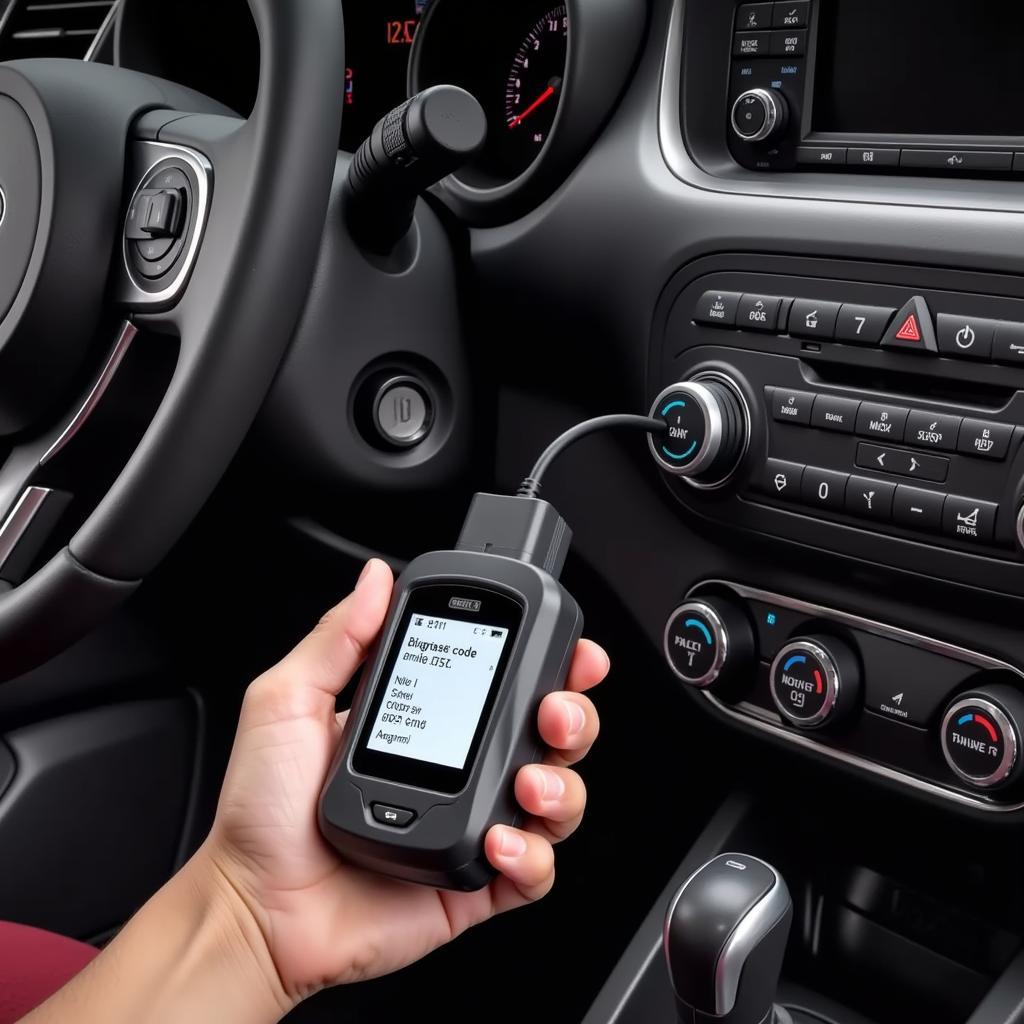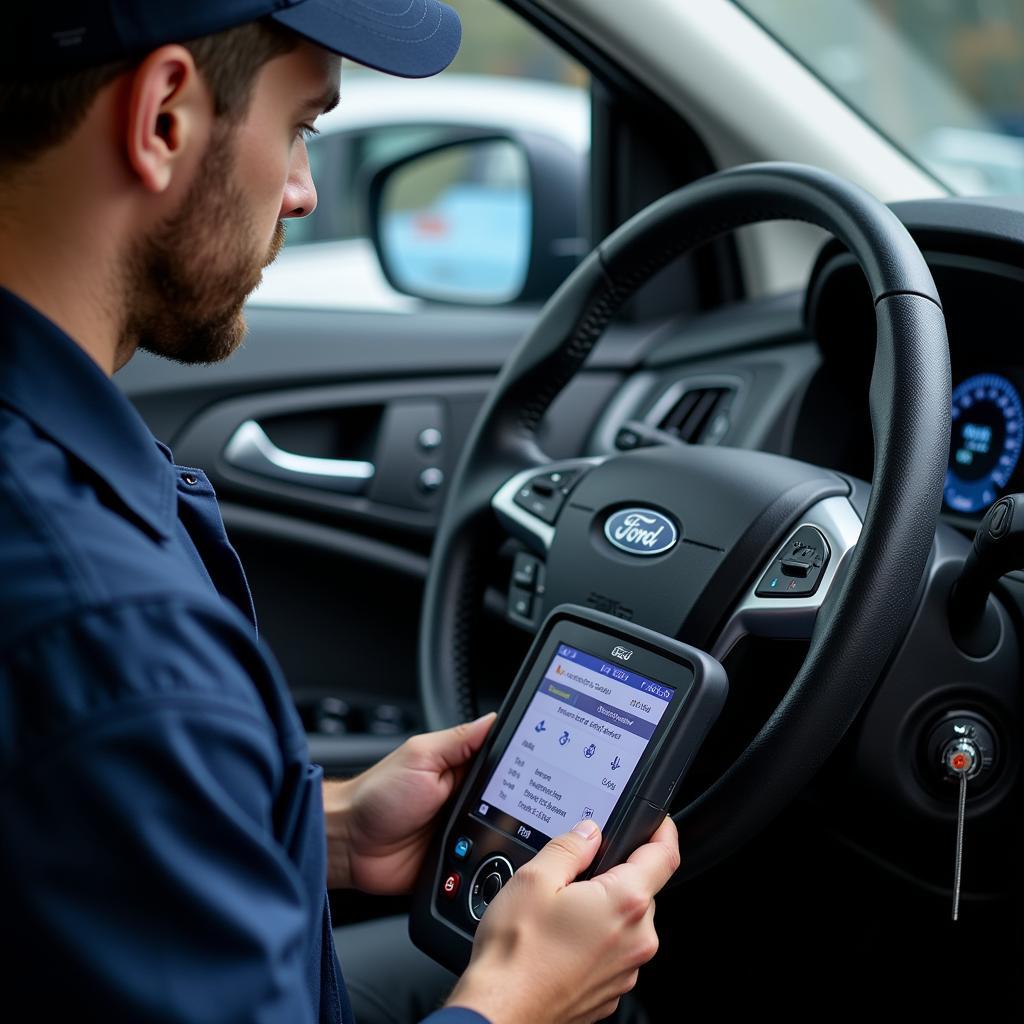Ever been stranded on the side of the road, engine light flashing like a disco ball, and no idea what’s wrong? You’re not alone. A lot of us have been there, feeling like a helpless pup under the hood of our car. Thankfully, the world of automotive diagnostics has evolved, and now we have powerful tools like OBD2 scan tools that can help us get to the bottom of these mysteries.
But with so many OBD2 scan tools on the market, how do you know which one is right for you? That’s where this guide comes in. We’re going to dive deep into the world of OBD2 scan tools, exploring their functionalities, the various types available, and ultimately helping you find the perfect tool to conquer any automotive challenges.
What is an OBD2 Scan Tool?
The OBD2 (On-Board Diagnostics 2) system is a standard diagnostic interface found in most gasoline vehicles manufactured in the United States after 1996 and in the European Union after 2001. An OBD2 scan tool, essentially, is a device that plugs into the OBD2 port, the rectangular connector usually located under your dashboard, allowing you to communicate with your car’s computer.
This communication provides access to a wealth of information, including:
- Engine Trouble Codes (DTCs): These codes identify specific issues within the engine control system.
- Real-Time Data: Get real-time data streams from various sensors such as engine speed, coolant temperature, and throttle position.
- Freeze Frame Data: Record the conditions of the vehicle at the time a fault code is registered.
- Live Data: Track specific vehicle parameters in real-time.
- Vehicle Identification Information: Access crucial information about your vehicle, including its Vehicle Identification Number (VIN), calibration, and software version.
Why Do You Need an OBD2 Scan Tool?
Having an OBD2 scan tool in your toolbox is like having a Swiss Army knife for your car:
- Diagnose Engine Problems: It acts like a detective, revealing the root cause of a check engine light by providing detailed diagnostic codes.
- Save Money: Instead of blindly throwing parts at your car, an OBD2 scan tool can pinpoint the issue, saving you unnecessary costs.
- Monitor Vehicle Health: Stay on top of your car’s performance by checking sensor data and identifying potential problems early on.
- Gain More Control: Understand your car’s performance better, allowing you to make more informed decisions regarding maintenance and upgrades.
The Best OBD2 Scan Tool – What to Look For:
Now let’s talk about finding the right OBD2 scan tool. It’s like choosing a trusty sidekick for your automotive adventures. Here are some key features to consider:
1. Compatibility:
- OBD2 Compatibility: Make sure the tool is compatible with your car’s OBD2 protocol. Most modern tools support both OBD2 and earlier protocols.
- Vehicle Compatibility: Some tools are more versatile and can work with a wider range of vehicles, including European, Asian, and American cars. This is particularly important if you work on a variety of cars or are planning to work on newer models.
2. Features:
- Code Reading: Basic tools can read and clear codes, while advanced tools offer more detailed code information.
- Live Data: The ability to view live data streams from various sensors can be extremely helpful for diagnosing performance issues.
- Freeze Frame Data: Allows you to see what was happening when a code was triggered.
- Special Functions: Look for features such as ABS bleeding, airbag resetting, or sensor testing, depending on your needs.
3. Display:
- Screen Size: A larger screen can be easier to read, especially for complex information.
- Resolution: Sharp displays provide clear visuals for data and graphs.
- Backlit: A backlit screen is essential for working in low light conditions.
4. Ease of Use:
- User Interface: Choose a tool with an intuitive interface that’s easy to navigate.
- Connectivity: Look for tools that support Bluetooth or Wi-Fi for wireless connectivity to your smartphone or computer.
5. Software:
- Updates: Ensure the tool’s software can be updated to support new vehicle models and features.
- Compatibility: Consider the platform compatibility (Windows, Mac, Android, iOS).
6. Price:
- Budget: Scan tools range in price from basic models for under $20 to advanced professional-grade tools that can cost hundreds of dollars.
****
Top OBD2 Scan Tools for Different Needs:
Here are some popular OBD2 scan tools categorized based on user needs:
1. Best Overall OBD2 Scan Tool:
The [Professional name of OBD2 scan tool] is a top-rated choice for both home mechanics and professionals. It boasts a comprehensive set of features, including live data, freeze frame data, and support for various protocols.
Features:
- Supports all 10 OBD2 protocols.
- Large color screen for easy viewing.
- Intuitive interface and robust software with regular updates.
- Powerful data analysis capabilities for diagnosing engine issues.
Who is it for:
- Experienced Mechanics: This tool is designed for professionals who demand the most comprehensive diagnostic capabilities.
- Advanced Home Mechanics: DIYers who want to delve deeper into their car’s systems will appreciate the tool’s advanced features.
2. Best Budget-Friendly OBD2 Scan Tool:
For those on a budget, the [Name of budget OBD2 scan tool] is a great option. It’s a basic tool that offers code reading, clearing, and some live data viewing.
Features:
- Basic code reading and clearing capabilities.
- Limited live data viewing.
- Affordable price point.
Who is it for:
- Occasional DIYers: If you only need to diagnose basic engine problems occasionally, this tool can provide you with enough information.
- First-Time Buyers: It’s a good entry-level tool for those who are new to OBD2 diagnostics.
3. Best OBD2 Scan Tool for European Cars:
[Name of OBD2 scan tool for European cars] is a popular choice for diagnosing European vehicles. It offers specialized features for European car models.
Features:
- Supports specific European protocols.
- Provides detailed information for European vehicles.
- May include advanced functions such as ABS bleeding and airbag resetting.
Who is it for:
- European Car Owners: If you own a European car, this tool is designed to provide you with the most accurate and comprehensive diagnostics.
4. Best OBD2 Scan Tool for Smartphones:
For those who prefer the convenience of using their smartphone, the [Name of OBD2 scan tool for smartphones] is a fantastic option. It connects wirelessly via Bluetooth to your smartphone and uses a dedicated app for diagnostics.
Features:
- Wireless Connectivity: Connect to your smartphone using Bluetooth.
- App-Based Interface: A user-friendly app for viewing data and diagnostics.
- Wide Compatibility: Many smartphone-compatible tools support a broad range of vehicles.
Who is it for:
- Tech-Savvy Individuals: If you’re comfortable using apps on your phone, this option offers a seamless and convenient experience.
****
Frequently Asked Questions (FAQs)
What are the differences between a basic OBD2 scan tool and an advanced one?
A basic OBD2 scan tool primarily focuses on reading and clearing trouble codes. It typically has a limited display and lacks advanced features like live data viewing.
An advanced OBD2 scan tool offers a comprehensive range of functionalities, including:
- Live data: Real-time data streams from various sensors.
- Freeze frame data: Capture the vehicle’s conditions when a code was triggered.
- Advanced features: ABS bleeding, airbag resetting, sensor testing, and more.
How do I know if my car is compatible with an OBD2 scan tool?
Most gasoline vehicles manufactured after 1996 in the United States and 2001 in the European Union are equipped with an OBD2 port. To confirm compatibility, look for a rectangular connector with 16 pins located under your dashboard, typically near the steering column.
Can an OBD2 scan tool tell me how to fix a problem?
While an OBD2 scan tool can identify the issue, it doesn’t always provide instructions on how to fix it. It’s best to consult a repair manual or a mechanic for specific repair procedures.
Can an OBD2 scan tool clear a check engine light?
Yes, an OBD2 scan tool can clear a check engine light. However, clearing the light doesn’t mean the problem is fixed. It simply clears the stored code. If the issue persists, the light will likely reappear.
Conclusion:
Finding the right OBD2 scan tool depends on your specific needs and budget. Whether you’re a seasoned mechanic or a curious car owner, having an OBD2 scan tool can be a valuable asset for understanding your car’s health and diagnosing potential issues.
We encourage you to explore the various options available and choose the tool that best fits your requirements. Don’t hesitate to reach out to us if you have any questions or need assistance choosing the right tool for you.
For expert assistance with diagnostics and installation, connect with us on WhatsApp at +84767531508. Our team of automotive professionals is available 24/7 to help you troubleshoot any issues.
And remember, don’t be afraid to get your hands dirty and explore the fascinating world of automotive diagnostics!
****


